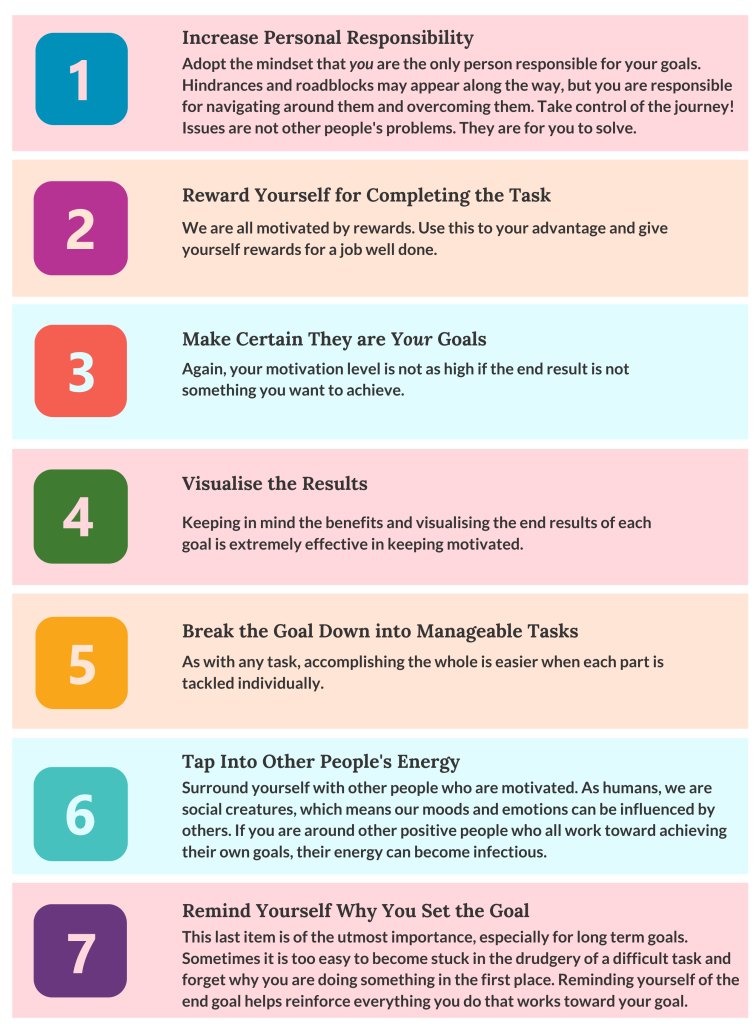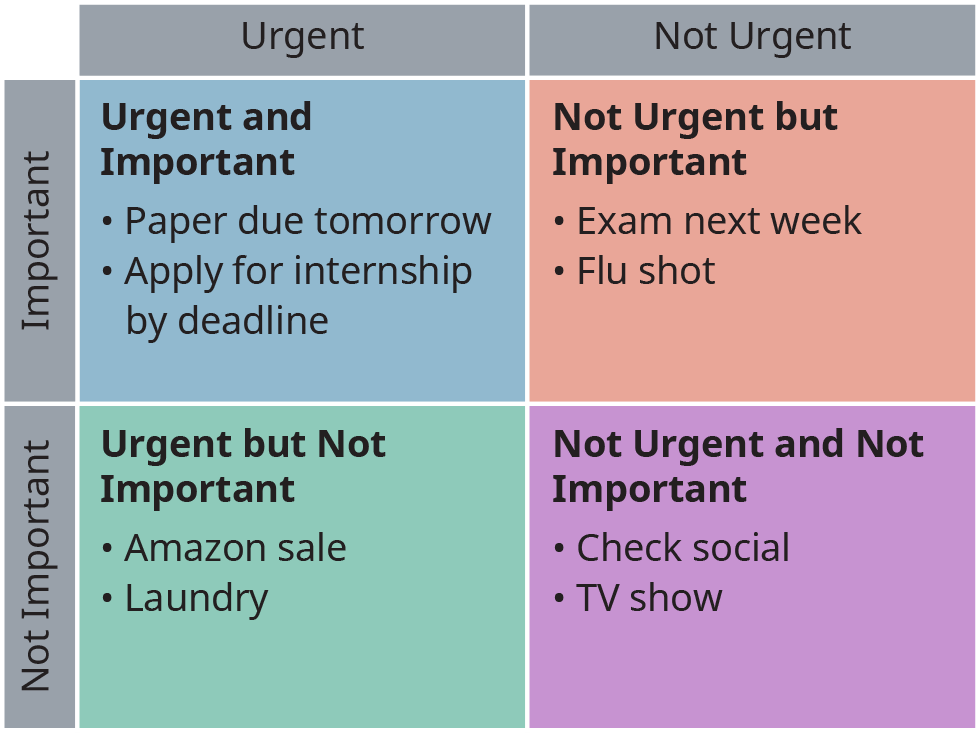Goals and Priorities
Colleen Kaesehagen

Selecting goals and priorities has the power to put you on track and on time in your journey to academic success. This chapter provides strategies to help you get the best out of every day, every week and every year at university. The chapter discusses motivation, shows you how to construct SMART goals and how to “stick” with them. It also talks about long-term and short-term goals, how to prioritise to complete tasks and work to deadlines.
Goals Give Motivation
Motivation often means the difference between success and failure. That applies to school, to specific tasks, and to life in general. One of the most effective ways to keep motivated is to set goals. Goals can be big or small. A goal can range from I am going to write one extra page tonight, to I am going to work to get an A in this course, and all the way to I am going to graduate in the top of my class so I can start my career with a really good position. Goals work towards the bigger picture. For example, if your goal is to get an A in a certain course, all the reading, studying, and every assignment you do for that course contributes to the larger goal. You are motivated to do each of those things and to do them well. Goal setting is best done with careful thought and planning. This next section will explain how you can apply strategies to set goals.
SMART Goals
Goals need to be specific and represent an end result. They should also be SMART (Specific, Measurable, Achievable, Relevant, and Time-bound). A SMART goal will help you achieve an end result and support your decision making. Each component of a SMART goal will be described in more detail below.
- Specific—For a goal to be specific, it must be carefully defined. A goal of get a good job when I graduate is too general. It doesn’t define what a good job is. A more specific goal would be something like identify a hospital that recruits graduate nurses and has clear career paths.
- Measurable—To show effect, and report progress, goals need to be measured. What this means is that the goal should have clearly defined outcomes with enough detail to measure them. For example, setting a goal of doing well at university is a bit undefined, but making a goal of graduating with a grade point average (GPA) above 4.0 at university is measurable and something you can work with.
- Attainable—Attainable or achievable goals means they are reasonable and within your ability to accomplish. While a goal to complete six subjects in a semester and work part time is something that would be nice to achieve, the odds that you could make that happen in a semester are not very realistic for most students. However, if you plan to complete three subjects this semester and work part time it may well be more achievable.
- Relevant—For goal setting, relevant means it applies to the situation. In relation to university, a goal of buying a horse to ride to for pleasure on weekends is unlikely to be relevant to your student goals, particularly if you live 100km from campus, but getting dependable transportation to the campus is something that would contribute to your success at university.
- Time-bound—Time-bound means you set a specific time frame to achieve the goal. I will get my paper written by Wednesday is time-bound. You know when you must meet the goal. I will get my paper written sometime soon does not help you plan how and when you will accomplish the goal.
In the following table you can see some examples of goals that do and do not follow the SMART system (see Table 1). As you read each one, think about what elements make them SMART or how you might change those that are not.
| Goal | Is it SMART? | Comments |
| I am going to be rich someday
|
No | There is nothing specific, measurable, or time-bound in this goal. |
| I will graduate with a GPA of 4.0 by the end of next year. | Yes | The statement calls out specific, measurable, and time-bound details. The other attributes of attainable and relevant are implied. This goal can also be broken down to create smaller, semester or even weekly goals. |
| I will walk for 30 mins each day to help me relieve stress. | Yes | All SMART attributes are covered in this goal, explicitly or implied. |
| I would like to do well in all my courses next semester. | No | While this is clearly time-bound and meets most of the SMART goal attributes, it is not specific or measurable without defining what “do well” means. |
| I will earn at least a 4.0 GPA in all my courses next semester by seeking help from the Learning Advisor (Maths). | Yes | All the SMART attributes are present in this goal. |
| I am going to start being more organised. | No | While most of the SMART attributes are implied, there is nothing really measurable in this goal. |
When goal setting it is important to write down your goals, keep them visible, and revisit each one every couple of weeks to make sure you are on track. It is also useful to discuss your goals with a critical friend who will help you to be realistic and support you to achieve your goals.
Stick With It!
The key to reaching goals is to stick with them, keep yourself motivated, and overcome obstacles along the way. In the graphic below, you will find seven methods successful people use to accomplish their goals (see Figure 7).

Keeping focused and motivated can be challenging as there are so many other things to do. Procrastination can be a problem when studying. How well we persevere towards goal or task can be referred to as “grit”. Grit drives us to succeed and to get back up when things seem hard. Grit is not about how clever you are, it is about how much you keep going until something is finished or accomplished.
Grit was defined by the psychologist Angela Duckworth and colleagues (Duckworth et al., 2007). They found that individuals with high grit were able to maintain motivation in learning tasks despite failures. The results showed that grit and perseverance were better predictors of academic success and achievement than talent or IQ. Paul Stoltz (2015) has since taken the grit concept and turned it into an acronym (GRIT) to help people remember and use the attributes of a grit mindset. His acronym is Growth, Resilience, Instinct, and Tenacity. Each element is explained in the table below (see Table 2).
| Growth | Your inclination to seek and consider new ideas, alternatives, different approaches, and fresh perspectives |
| Resilience | Your capacity to respond constructively and to manage all kinds of adversity |
| Instinct | Your capacity to pursue the right goals in the best and smartest ways |
| Tenacity | The degree to which you persist, commit to, stick with, and achieve your goals |
With a “grit” mindset comes an acceptance that you may not succeed on the first attempt—or the nineteenth attempt. Failed attempts are part of the process and seen as a very useful way to gain knowledge that moves you towards success. Sometimes we need to look at how we are doing something to find out why we are unsuccessful. When we are honest about the reasons why, we can then start to manage the situation and set goals. We get back up and start again.
Long-Term Goals and Short-Term Goals
Long-term goals are future goals that often take years to complete. An example of a long-term goal might be to complete a Bachelor of Arts degree within four years. Long-term goals are not exclusive to academic study. You might set long-term goals related to fitness, wellness, and relationships. When you set a long-term goal in any aspect of your life, you are demonstrating a commitment to dedicate time and effort towards making progress in that area.

Setting short-term goals helps you consider the necessary steps you’ll need to take, and also helps to chunk a larger effort into smaller, more manageable tasks. Even when your long-term goals are SMART, it’s easier to stay focused and you’ll become less overwhelmed in the process of completing short-term goals.
You might assume that short-term and long-term goals are different goals that vary in the length of time they take to complete. Instead of just being bound by the difference of time, short-term goals are the action steps that take less time to complete than a long-term goal, but that help you work towards your long-term goals.
Prioritisation

A key component in goal setting and time management is that of prioritisation. Prioritisation is ordering tasks and allotting time, based on their identified needs or value. To prioritise tasks you need to understand the requirements of each. If you have multiple assignments to complete and you assume one of those assignments will only take an hour, you may decide to put it off until the others are finished. Your assumption could be disastrous if you find, once you begin the assignment, that there are several extra components that you did not account for and the time to complete will be four times as long as you estimated. It is important to understand exactly what needs to be done to complete a task before you determine its priority.
To better see how things may need to be prioritised, you could make a list of tasks to be completed and then arrange them in a quadrant map based on importance and urgency. This is called the Eisenhower Decision Matrix.
Begin by making a list of things you need to do today and then draw the grid below. Write each item in one of the four squares. Choose the square that best describes it based on its urgency and its importance. When you have completed writing each of the tasks in its appropriate square, you will see a prioritisation order of your tasks. Those listed in the Important and Urgent square will be the things you need to finish first. After that will come things that are “important but not urgent,” followed by “not important, but urgent,” and finally “not urgent and not important” (see Figure 9).

It is also important to think of other impacts on your time. Keeping others informed about your priorities may help avert possible conflicts (e.g., letting your boss know you will need time on a certain evening to study; letting your friends know you plan to do a project on Saturday but can do something on Sunday, etc.). Time management in university is as much about managing all the elements of your life as it is about managing time for class and to complete assignments. Regardless of how much you have planned, sometimes events arise where it becomes almost impossible to accomplish everything you need to by the time required. As the saying goes, “things happen.” In this situation prioritisation becomes important. When this occurs with university assignments, it is important to not feel overwhelmed by the situation and rather to make an informed decision based on the value and impact of your choice.
Priority Conflicts
Imagine a situation where you have two assignments due at a similar time, and you must decide which one you to work on first. For example, one of the assignments may only be worth a minimal number of points towards your total grade, but it may be foundational to the rest of the course. The first step is to try to find a way to get everything finished. If that cannot happen, the next step would be to communicate with your lecturers to let them know about the situation. They may have options you had not considered. The key here is to make certain you are aware of and understand all the ramifications to help make the best decision when the situation dictates you make a hard choice among priorities.
Completing Tasks
Another important part of time management is to develop approaches that help you complete tasks in an efficient manner that works for you.
Knowing what you need to do
Understanding what you need to do and when you need to do it can be applied to any task, no matter how simple or how complex. Knowing what you need to do and planning for it can go a long way towards success. As you can see from the graphic below (see Figure 10), a task as simple as “going to class” can be broken down into a number of different elements that have are dependent on other tasks. One example of this is preparing for the class lecture by reading materials ahead of time in order to make the lecture and any complex concepts easier to follow. If you did it the other way around, you might miss opportunities to ask questions or receive clarification on the information presented during the lecture.

Knowing how you will get it done
After you have a clear understanding of what needs to be done to complete a task, the next step is to create a plan for completing everything. This may not be as easy or as simple as declaring that you will finish part one, then move on to part two, and so on. Each component may need different resources or skills to complete, and it is in your best interest to identify those ahead of time and include them as part of your plan.
Knowing what resources will you need

Make a list of the everything you will need to complete a task. If a missing resource is important, the entire project can come to a complete halt. Even if the missing resource is a minor component, it may still dramatically alter the end result. Learning activities are much the same in this way. List everything you need. It is also important to remember that resources may not be limited to physical objects such as paper or ink. Information can be a critical resource as well. In fact, one of the most often overlooked aspects in planning by new university students is just how much research, reading, and information they will need to complete assignments.
Knowing what skills will you need
Poor planning and assumptions can be disastrous. No matter how well you planned the other parts of the project, if there is some skill needed that you do not have and you have no idea how long it will take to learn, it can be a impact on your planning.
Imagine a scenario where your class projects is to create a poster. It is your intent to use some kind of imaging software to produce professional-looking graphics and charts for the poster, but you have never used the software in that way before. It seems easy enough, but once you begin, you find the charts keep printing out in the wrong resolution. You search online for a solution, but the only thing you can find requires you to recreate them all over again in a different setting. Unfortunately, that part of the project will now take twice as long.
It can be extremely difficult to recover from a situation like that, and it could have been prevented by taking the time to learn how to do it correctly before you began or by at least including in your schedule some time to learn and practise.
Set Deadlines
The best way to approach time management is to set realistic deadlines that take into account which elements are dependent on others and the order in which they should be completed. Giving yourself two days to write a ten page essay is not very realistic when even many professional authors average only six pages per day. Your intentions may be well founded, but your use of unrealistic deadlines will not be very successful. Setting appropriate deadlines and sticking to them is very important.
Be Flexible
The final item on this list after a strong encouragement to make deadlines and stick to them is the suggestion to be flexible. The reason that “be flexible” has made this list is because even the best-laid plans and most accurate time management efforts can take an unexpected turn. The idea behind being flexible is to readjust your plans and deadlines when something does happen to throw things off. The worst thing you could do in such a situation is panic or just stop working because the next step in your careful planning has suddenly become a roadblock. The moment when you see that something in your plan may become an issue is when to begin readjusting your plan.
Adjusting a plan along the way is incredibly common. It is a good idea to planning for problems, or delays from the beginning, and even add a little extra time for each task to help ensure an issue does not derail the entire project. As you work through tasks, make certain you are always monitoring and adapting to ensure you complete them.
Being flexible is helpful as sometimes it can feel overwhelming when there are too many changes needed within a short amount of time. It can help to stand back occasionally and look at the big picture to remind yourself of your major priorities for your life while at university. You may find it helpful to draw a learning map and place it on your wall to remind yourself of what really matters to you – where you will be flexible and where you won’t.

Conclusion
Goal setting and prioritisation are essential in the first year of university and beyond. Learning effective approaches to goal setting and managing priority conflicts takes time, but the steps covered in this chapter provide a strong foundation to get students started. Using a structured approach to identifying achievable goals that are personally meaningful allows you to plan for both short and long-term success. Overtime, prioritisation may also become easier as you gain experience. Keep the key points in mind to help maintain your motivation as you transition into university life.
Key points
- One of the most effective ways to keep motivated is to set goals.
- SMART Goals are a useful structured approach to plan, write down, commit to, and achieve meaningful goals.
- The key to reaching goals is to keep at it, keep yourself motivated, and overcome any obstacles along the way.
- Apply grit and adopt an attitude that looks directly to the end goal as the only acceptable outcome.
- Setting short-term goals helps you consider the necessary steps you’ll need to take to achieve your long-term goals, but it also helps to chunk a larger effort into smaller, more manageable tasks.
- Prioritisation is a key component of goal setting and time-management which involves ordering tasks, and allotting time for them based on their identified needs or value.
- If you find that you have a priority conflict, make certain you are aware of and understand all the ramifications to help make the best decision.
- Knowing what you need to do and planning for it can go a long way towards successfully completing tasks. You might need specific resources or skills.
References
Duckworth, A.L., Peterson, C., Matthews, M.D., & Kelly, D.R. (2007). Grit: Perseverance and passion for long-term goals. Journal of Personality and Social Psychology, 92(6), 1087–1101. https://doi.org/10.1037/0022-3514.92.6.1087
Stoltz, P. G. (2015). Leadership Grit. Leader to Leader, 78, 49–55. https://doi.org/10.1002/ltl.20205

